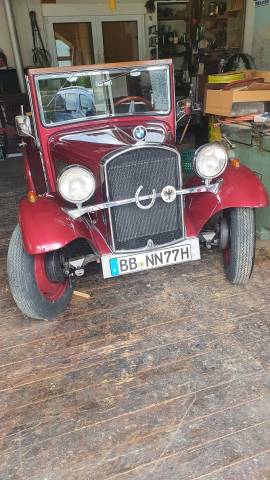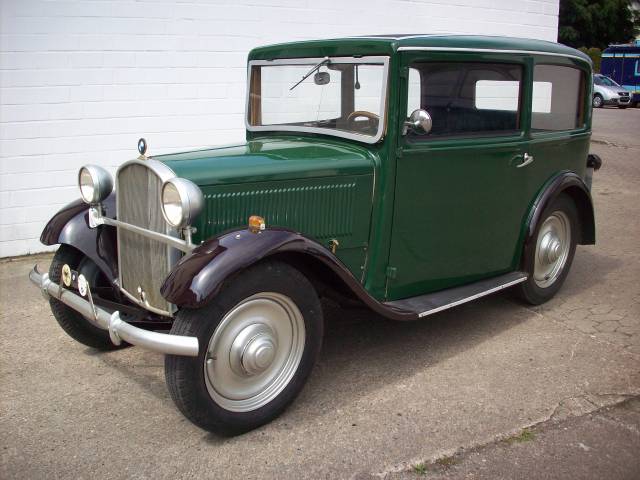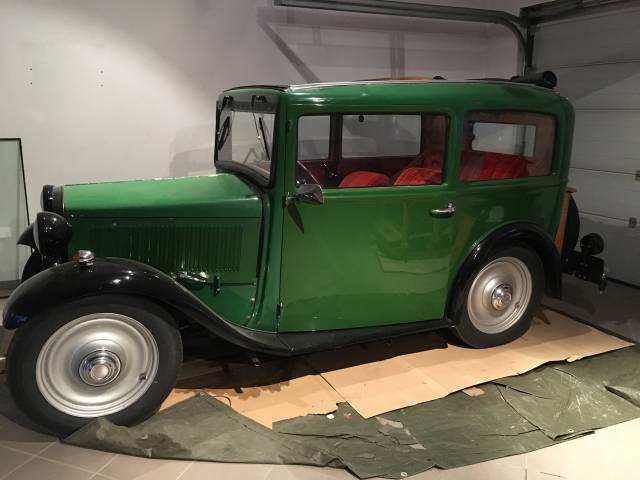BMW 3/20 classic cars for sale
The BMW 3/20, produced from 1932 to 1934, was BMW's pioneering move into fully self-developed automobiles. With a modern curved Bauhaus design, technical advancements, and available as both saloon and convertible, the 3/20 marks the beginning of BMW's legendary engineering tradition. The model is available in various body types, typically powered by a reliable petrol engine. Viewing and test drives are possible by prior arrangement.
Search results
Currently, there are no matching listings for your search.
Create search alert
Let yourself be notified as soon as a listing is published that matches your search filters.
Create listing
Do you have a BMW 3/20 that you want to sell? Then create a listing now.
Create listingBMW 3/20 listing references from Classic Trader
Below you will find listings related to your search that are no longer available on Classic Trader. Use this information to gain insight into availability, value trends, and current pricing for a "BMW 3/20" to make a more informed purchasing decision.

1932 | BMW 3/20 AM 4
BMW AM4 Prototyp nie in Serie
1933 | BMW 3/20 AM 2
Gepflegt und fahrtüchtig

1933 | BMW 3/20 AM 2
BMW Dixi AM 4
Create search alert
Let yourself be notified as soon as a listing is published that matches your search filters.
Create listing
Do you have a BMW 3/20 that you want to sell? Then create a listing now.
Create listingHistory of the BMW 3/20
The BMW 3/20 was the first automobile entirely developed by BMW, marking a significant milestone for the Bavarian brand. Built between 1932 and 1934, the 3/20 replaced the BMW 3/15, which was based on the licensed Austin 7 design. With the 3/20, BMW moved away from acquired technology and entered an era of self-designed vehicles. Engineers Alfred Böning and Max Friz, with input from the critical automotive journalist Josef Ganz, shaped a car that addressed the limitations of its predecessor and introduced innovations to the compact segment. Appealing to the middle class of the time, the 3/20 offered style, comfort, and technical refinement, establishing BMW's engineering independence. In total, 7,215 units were manufactured before production ended in favour of more advanced six-cylinder models.
Model history
The 3/20 was introduced as the successor to the Dixi 3/15, BMW’s first car, and represents the manufacturer’s first fully proprietary design. It was produced in four versions, known as AM-1 to AM-4. Early models featured a three-speed manual transmission, which was later updated to a four-speed in the final AM-4 revision. After the 3/20, BMW released the 303, a six-cylinder saloon, marking the company’s continued evolution towards higher performance and larger vehicles.
Highlights of the BMW 3/20
The BMW 3/20 brought several technical and design innovations to the compact car class of its era. The backbone chassis, independent front and rear swing axle suspension, and introduction of an overhead valve engine set new standards for small cars in the early 1930s. The 3/20 was also the first car to bear the now-iconic round BMW badge on its grille. Notably, its bodywork, supplied by Daimler-Benz, offered more interior space than the 3/15, with rounded contours and practical access panels for engine maintenance. Three body styles were available: a four-seat saloon, a cabriolet, and a two-seater coupé.
Technical data
Special Editions and Collectible Models
The 3/20 was produced in four main variants, named AM-1 through AM-4, with improvements in gearbox and chassis. While there were no limited production runs, the different body styles—saloon, four-seater cabriolet, and two-seater convertible coupé—offer variety for collectors. Some rare commercial-bodied versions were also assembled.
Weak Spots and Common Issues
Age-related wear is typical for BMW 3/20 models, including paint, bodywork, and mechanical components. Well-maintained examples show good preservation of the chassis, brakes, and underbody. As with most pre-war vehicles, potential buyers should look for signs of corrosion on the chassis and inspect the suspension components, especially the independent swing axle system. Parts availability can be a challenge, and regular inspection is recommended for all mechanical systems.
Engine and performance, transmission and handling
Driving the BMW 3/20 offers a glimpse into early 1930s engineering. The 782cc four-cylinder produces 20 hp at 3,500 rpm, which, combined with a lightweight chassis, allows for a top speed of up to 80 km/h. The manual transmission—three-speed in early models, four-speed in later AM-4—offers period-correct gear changes. The independent suspension delivers surprisingly good ride comfort for the era and helps to deliver confident handling on contemporary roads. Braking is mechanical and unassisted, requiring firm pedal input—typical for vehicles of this period. - BMW 3/20 AM-4: Final version featuring a four-speed gearbox and what is widely regarded as the most refined setup in terms of handling and mechanical durability.
Interior, comfort, exterior and design
The design of the BMW 3/20 reflects early 1930s trends with rounded forms and understated elegance. The centrally mounted BMW badge on the grille references the manufacturer’s new identity. Body panels are gently curved, with two side panels to access the engine bay. Prominent round headlamps sit above exposed fenders, and white, flat steel wheels complete the exterior look. The interior prioritises simplicity and space efficiency, with notable improvements in passenger room over the 3/15. Depending on configuration, buyers could choose between a closed saloon, cabriolet, or coupé. Special accessories, such as period-correct luggage racks, heater units, or upgraded seating, were available from BMW or aftermarket suppliers.
Other features
Viewing and test drives are possible by prior appointment. Telephone consultation enables pre-clarification before the physical inspection. The BMW 3/20 was sometimes also known as the Dixi AM 4, a name used for certain export or transitional models within the production run.
Summary
The BMW 3/20 signaled the start of BMW’s journey as an independent automotive designer and manufacturer. Between 1932 and 1934, the model set new technical standards in the compact class while retaining reliable, straightforward mechanics. With several body styles and incremental technical improvements, the 3/20 remains an engaging proposition for enthusiasts and collectors interested in authentic pre-war BMW engineering.
